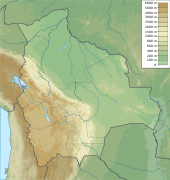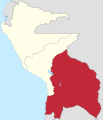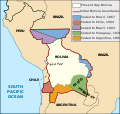Portal:Bolivia
| Portal | WikiProject | Peer Review | Assessment | Task Force |
IntroductionWelcome to the Bolivia portal
  Bolivia, officially the Plurinational State of Bolivia, is a landlocked country located in western-central South America. It is bordered by Brazil to the north and east, Paraguay to the southeast, Argentina to the south, Chile to the southwest, and Peru to the west. The seat of government and administrative capital is La Paz, which contains the executive, legislative, and electoral branches of government, while the constitutional capital is Sucre, the seat of the judiciary. The largest city and principal industrial center is Santa Cruz de la Sierra, located on the Llanos Orientales (eastern tropical lowlands), a mostly flat region in the east of the country. The sovereign state of Bolivia is a constitutionally unitary state divided into nine departments. Its geography varies as the elevation fluctuates, from the western snow-capped peaks of the Andes to the eastern lowlands, situated within the Amazon basin. One-third of the country is within the Andean mountain range. With an area of 1,098,581 km2 (424,164 sq mi), Bolivia is the fifth-largest country in South America after Brazil, Argentina, Peru and Colombia, and, alongside Paraguay, is one of two landlocked countries in the Americas. It is the 27th largest country in the world, the largest landlocked country in the Southern Hemisphere, and the seventh largest landlocked country on earth, after Kazakhstan, Mongolia, Chad, Niger, Mali, and Ethiopia. Bolivia experienced a succession of military and civilian governments until Hugo Banzer led a CIA-supported coup d'état in 1971, replacing the socialist government of Juan José Torres with a military dictatorship. Banzer's regime cracked-down on left-wing and socialist opposition parties, and other perceived forms of dissent, resulting in the torturing and murders of countless Bolivian citizens. Banzer was ousted in 1978 and, twenty years later, returned as the democratically elected President of Bolivia (1997–2001). Under the 2006–2019 presidency of Evo Morales, the country saw significant economic growth and political stability, but was also widely accused of democratic backsliding and was described as a competitive authoritarian regime. Freedom House classifies Bolivia as a partly-free democracy as of 2023, with a 66/100 score. (Full article...) Selected article -The War of the Pacific (Spanish: Guerra del Pacífico), also known as the Nitrate War (Spanish: Guerra del salitre) and by multiple other names, was a war between Chile and a Bolivian–Peruvian alliance from 1879 to 1884. Fought over Chilean claims on coastal Bolivian territory in the Atacama Desert, the war ended with victory for Chile, which gained a significant amount of resource-rich territory from Peru and Bolivia. The direct cause of the war was a nitrate taxation dispute between Bolivia and Chile, with Peru being drawn in due to its secret alliance with Bolivia. Some historians have pointed to deeper origins of the war, such as the interest of Chile and Peru in the nitrate business, a long-standing rivalry between Chile and Peru for regional hegemony, as well as the political and economical disparities between the stability of Chile and the volatility of Peru and Bolivia. On February 1878, Bolivia increased taxes on the Chilean mining company Compañía de Salitres y Ferrocarril de Antofagasta (CSFA), in violation of the Boundary Treaty of 1874 which established the border between both countries and prohibited tax increases for mining. Chile protested the violation of the treaty and requested international arbitration, but the Bolivian government, presided by Hilarión Daza, considered this an internal issue subject to the jurisdiction of the Bolivian courts. Chile insisted that the breach of the treaty would mean that the territorial borders denoted in it were no longer settled. Despite this, Hilarión Daza rescinded the license of the Chilean company, seized its assets and put it up for auction. On the day of the auction, February 14, 1879, Chile's armed forces occupied without resistance the Bolivian port city of Antofagasta, which was mostly inhabited by Chilean miners. War was declared between Bolivia and Chile on March 1, 1879, and between Chile and Peru on April 5, 1879. (Full article...)Did you know (auto-generated)
Selected pictureTopicsLargest populated areas
Related portals
WikiProjectsAssociated WikimediaDiscover Wikipedia using portals New ArticlesThis list was generated from these rules. Questions and feedback are always welcome! The search is being run daily with the most recent ~14 days of results. Note: Some articles may not be relevant to this project.
Rules | Match log | Results page (for watching) | Last updated: 2024-05-21 20:11 (UTC) Note: The list display can now be customized by each user. See List display personalization for details.
| |||||||||||||||||||||||||||||||||||||||||||||||||||||||||||||||||||||||||||||||||||||||||||||||||||||||||||||||||||||||||||||||||||||||||||||||||||||
































































